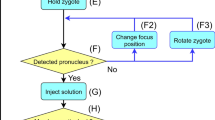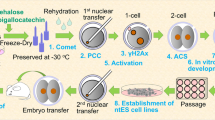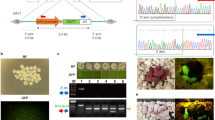Abstract
Although it has now been 10 years since the first cloned mammals were generated from somatic cells using nuclear transfer (NT), the success rate for producing live offspring by cloning remains <5%. Nevertheless, the techniques have potential as important tools for future research in basic biology. We have been able to develop a stable NT method in the mouse, in which donor nuclei are directly injected into the oocyte using a piezo-actuated micromanipulator. Although manipulation of the piezo unit is complex, once mastered it is of great help not only in NT experiments but also in almost all other forms of micromanipulation. In addition to this technique, embryonic stem (ES) cell lines established from somatic cell nuclei by NT can be generated relatively easily from a variety of mouse genotypes and cell types. Such NT-ES cells can be used not only for experimental models of human therapeutic cloning but also as a backup of the donor cell's genome. Our most recent protocols for mouse cloning, as described here, will allow the production of cloned mice in ≥3 months.
This is a preview of subscription content, access via your institution
Access options
Subscribe to this journal
Receive 12 print issues and online access
$259.00 per year
only $21.58 per issue
Buy this article
- Purchase on Springer Link
- Instant access to full article PDF
Prices may be subject to local taxes which are calculated during checkout







Similar content being viewed by others
References
McGrath, J. & Solter, D. Inability of mouse blastomere nuclei transferred to enucleated zygotes to support development in vitro. Science 226, 1317–1319 (1984).
Willadsen, S.M. Nuclear transplantation in sheep embryos. Nature 320, 63–65 (1986).
Tsunoda, Y. et al. Full-term development of mouse blastomere nuclei transplanted into enucleated two-cell embryos. J. Exp. Zool. 242, 147–151 (1987).
Wilmut, I., Schnieke, A.E., McWhir, J., Kind, A.J. & Campbell, K.H. Viable offspring derived from fetal and adult mammalian cells. Nature 385, 810–813 (1997).
Kono, T., Tsunoda, Y. & Nakahara, T. Production of identical twin and triplet mice by nuclear transplantation. J. Exp. Zool. 257, 214–219 (1991).
Tsunoda, Y. & Kato, Y. Full-term development after transfer of nuclei from 4-cell and compacted morula stage embryos to enucleated oocytes in the mouse. J. Exp. Zool. 278, 250–254 (1997).
Tsunoda, Y. & Kato, Y. Not only inner cell mass cell nuclei but also trophectoderm nuclei of mouse blastocysts have a developmental totipotency. J. Reprod. Fertil. 113, 181–184 (1998).
Tsunoda, Y. & Kato, Y. A manual for nuclear transfer is missing. in Nuclear Transfer Technology in Transgenic Animal Technology, A Laboratory Handbook, 2nd edn. (ed. Pinkert, C.A.) 195–231 (Academic Press, Amsterdam, 2002).
Kimura, Y. & Yanagimachi, R. Intracytoplasmic sperm injection in the mouse. Biol. Reprod. 52, 709–720 (1995).
Wakayama, T. et al. Differentiation of embryonic stem cell lines generated from adult somatic cells by nuclear transfer. Science 292, 740–743 (2001).
Kawase, Y. et al. Application of the piezo-micromanipulator for injection of embryoic stem cells into mouse blastocysts. Contemp. Top. Lab. Anim. Sci. 40, 31–4 (2001).
Wakayama, T., Perry, A.C., Zuccotti, M., Johnson, K.R. & Yanagimachi, R. Full-term development of mice from enucleated oocytes injected with cumulus cell nuclei. Nature 394, 369–374 (1998).
Wakayama, T. & Yanagimachi, R. Cloning of male mice from adult tail-tip cells. Nat. Genet. 22, 127–128 (1999).
Ogura, A. et al. Production of male cloned mice from fresh, cultured, and cryopreserved immature Sertoli cells. Biol. Reprod. 62, 1579–1584 (2000).
Wakayama, T. & Yanagimachi, R. Mouse cloning with nucleus donor cells of different age and type. Mol. Reprod. Dev. 58, 376–383 (2001).
Ono, Y., Shimozawa, N., Ito, M. & Kono, T. Cloned mice from fetal fibroblast cells arrested at metaphase by a serial nuclear transfer. Biol. Reprod. 64, 44–50 (2001).
Wakayama, T., Rodriguez, I., Perry, A.C., Yanagimachi, R. & Mombaerts, P. Mice cloned from embryonic stem cells. Proc. Natl. Acad. Sci. USA 96, 14984–14989 (1999).
Inoue, K. et al. Generation of cloned mice by direct nuclear transfer from natural killer T cells. Curr. Biol. 15, 1114–1118 (2005).
Miki, H. et al. Birth of mice produced by germ cell nuclear transfer. Genesis 41, 81–86 (2005).
Inoue, K. et al. Inefficient reprogramming of the hematopoietic stem cell genome following nuclear transfer. J. Cell Sci. 119, 1985–1991 (2006).
Yamazaki, Y. et al. Assessment of the developmental totipotency of neural cells in the cerebral cortex of mouse embryo by nuclear transfer. Proc. Natl. Acad. Sci. USA 98, 14022–14026 (2001).
Inoue, K. et al. Effects of donor cell type and genotype on the efficiency of mouse somatic cell cloning. Biol. Reprod. 69, 1394–1400 (2003).
Boiani, M., Eckardt, S., Scholer, H.R. & McLaughlin, K.J. Oct4 distribution and level in mouse clones: consequences for pluripotency. Genes Dev. 16, 1209–1219 (2002).
Tanaka, S. et al. Placentomegaly in cloned mouse concepti caused by expansion of the spongiotrophoblast layer. Biol. Reprod. 65, 1813–1821 (2001).
Tamashiro, K.L. et al. Cloned mice have an obese phenotype not transmitted to their offspring. Nat. Med. 8, 262–267 (2002).
Ogonuki, N. et al. Early death of mice cloned from somatic cells. Nat. Genet. 30, 253–254 (2002).
Munsie, M.J. et al. Isolation of pluripotent embryonic stem cells from reprogrammed adult mouse somatic cell nuclei. Curr. Biol. 10, 989–992 (2000).
Wakayama, T. et. al. Equivalency of nuclear transfer-derived embryonic stem cells to those derived from fertilized mouse blastocysts. Stem Cells, published online 2006. http://stemcells.alphamedpress.org/cgi/reprint/2005-0537v1.pdf
Wakayama, S. et al. Mice cloned by nuclear transfer from somatic and ntES cells derived from the same individuals. J. Reprod. Dev. 51, 765–772 (2005).
Rideout, W.M., Hochedlinger, K., Kyba, M., Daley, G.Q. & Jaenisch, R. Correction of a genetic defect by nuclear transplantation and combined cell and gene therapy. Cell 109, 17–27 (2002).
Hochedlinger, K. & Jaenisch, R. Monoclonal mice generated by nuclear transfer from mature B and T donor cells. Nature 415, 1035–1038 (2002).
Eggan, K. et al. Mice cloned from olfactory sensory neurons. Nature 428, 44–49 (2004).
Li, J., Ishii, T., Feinstein, P. & Mombaerts, P. Odorant receptor gene choice is reset by nuclear transfer from mouse olfactory sensory neurons. Nature 428, 393–399 (2004).
Blelloch, R.H. et al. Nuclear cloning of embryonal carcinoma cells. Proc. Natl. Acad. Sci. USA 101, 13985–13990 (2004).
Hochedlinger, K. et al. Reprogramming of a melanoma genome by nuclear transplantation. Genes Dev. 18, 1875–1885 (2004).
Wakayama, S. et al. Establishment of male and female nuclear transfer embryonic stem cell lines from different mouse strains and tissues. Biol. Reprod. 72, 932–936 (2005).
Wakayama, S. et al. Propagation of an infertile hermaphrodite mouse lacking germ cells by using nuclear transfer and embryonic stem cell technology. Proc. Natl. Acad. Sci. USA 102, 29–33 (2005).
Kishigami, S. et al. Significant improvement of mouse cloning technique by treatment with trichostatin A after somatic nuclear transfer. Biochem. Biophys. Res. Commun. 340, 183–189 (2006).
Rybouchkin, A., Kato, Y. & Tsunoda, Y. Role of histone acetylation in reprogramming of somatic nuclei following nuclear transfer. Biol. Reprod., 74, 1089–1098 (2006).
Boiani, M., Eckardt, S., Leu, N.A., Scholer, H.R. & McLaughlin, K.J. Pluripotency deficit in clones overcome by clone-clone aggregation: epigenetic complementation? EMBO J. 22, 5304–5312 (2003).
Nagy, A., Gertsenstein, M., Vintersten, K. & Behringer, R. Manipulating the Mouse Embryo. (Cold Spring Harbor Laboratory Press, Cold Spring Harbor, NY, 2003).
Wakayama, S. et al. Production of offspring from one-day-old oocytes stored at room temperature. J. Reprod. Dev. 50, 627–637 (2004).
Schatten, G., Smith, J., Navara, C., Park, J.H. & Pedersen, R. Culture of human embryonic stem cells. Nat. Methods 2, 455–463 (2005).
Wakayama, T. & Yanagimachi, R. Effect of cytokinesis inhibitors, DMSO and the timing of oocyte activation on mouse cloning using cumulus cell nuclei. Reproduction 122, 49–60 (2001).
Cavaleri, F., Gentile, L., Schö ler, H.R. & Boiani, M. Recombinant human albumin supports development of somatic cell nuclear transfer embryos in mice: toward the establishment of a chemically defined cloning protocol. Cloning Stem Cells 8, 24–40 (2006).
Elsheikh, A.S., Takahashi, Y., Nagano, M. & Kanagawa, H. Manipulated mouse embryos as bioassay system for water quality control. Reprod. Domest. Anim. 38, 204–208 (2003).
Hartshorn, C., Rice, J.E. & Wangh, L.J. Differential pattern of Xist RNA accumulation in single blastomeres isolated from 8-cell stage mouse embryos following laser zona drilling. Mol. Reprod. Dev. 64, 41–51 (2003).
Wakayama, T. & Yanagimachi, R. Cloning the laboratory mouse. Semin. Cell Dev. Biol. 10, 253–258 (1999).
Ogawa, K., Matsui, H., Ohtsuka, S. & Niwa, H. A novel mechanism for regulating clonal propagation of mouse ES cells. Genes Cells 9, 471–477 (2004).
Wakayama, T. Establishment of ES cell lines from adult somatic cells by nuclear transfer. in Cell Biology: A Laboratory Handbook 3rd edn vol. 1 (ed. Celis, J.) 87–95 (Academic Press, San Diego, 2006).
Kishigami, S. et al. Epigenetic abnormalities of the mouse paternal zygotic genome associated with microinsemination of round spermatids. Dev. Biol. 289, 195–205 (2006).
Wakayama, T. & Yanagimachi, R. Development of normal mice from oocytes injected with freeze-dried spermatozoa. Nat. Biotechnol. 16, 639–641 (1998).
Author information
Authors and Affiliations
Corresponding authors
Ethics declarations
Competing interests
The authors declare no competing financial interests.
Supplementary information
Rights and permissions
About this article
Cite this article
Kishigami, S., Wakayama, S., Van Thuan, N. et al. Production of cloned mice by somatic cellnuclear transfer. Nat Protoc 1, 125–138 (2006). https://doi.org/10.1038/nprot.2006.21
Published:
Issue Date:
DOI: https://doi.org/10.1038/nprot.2006.21
This article is cited by
-
De novo DNA methylation drives 5hmC accumulation in mouse zygotes
Nature Cell Biology (2016)
-
Induction of autophagy improves embryo viability in cloned mouse embryos
Scientific Reports (2015)
-
Generation of knockout rabbits using transcription activator-like effector nucleases
Cell Regeneration (2014)
-
Therapeutic potential of somatic cell nuclear transfer for degenerative disease caused by mitochondrial DNA mutations
Scientific Reports (2014)
Comments
By submitting a comment you agree to abide by our Terms and Community Guidelines. If you find something abusive or that does not comply with our terms or guidelines please flag it as inappropriate.



